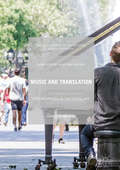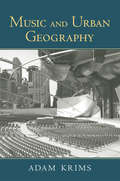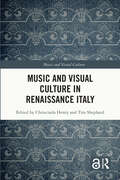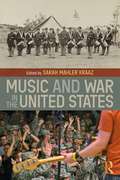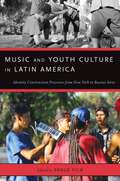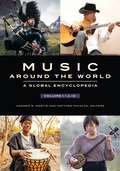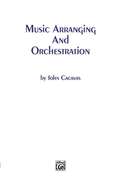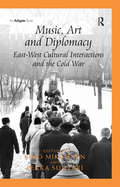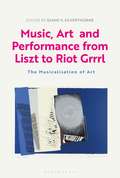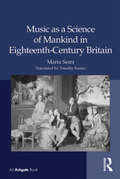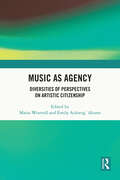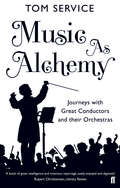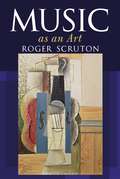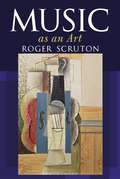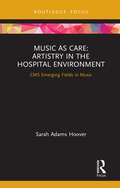- Table View
- List View
Music and Translation: New Mediations in the Digital Age (Palgrave Studies in Translating and Interpreting)
by Lucile DesblacheThis book explores how transformations and translations shape musical meanings, developments and the perception of music across cultures. Starting with the concept of music as multimodal text, the author understands translation as the process of transferring a text from one language – verbal or not – into another, interlingually, intralingually or intersemiotically, as well as the products that are derived from this process. She situates music and translation within their contemporary global context, examining the tensions between local and global, cosmopolitan and national, and universal and specific settings, to arrive at a celebration of the translational power of music and an in-depth study of how musical texts are translated. This book will be of interest to translation studies scholars who want to broaden their horizons, as well as to musicians and music scholars seeking to understand how cultural exchange and dissemination can be driven by translation.
Music and Urban Geography
by Adam KrimsMusic and Urban Geography is the first book to theorize musical aspects of the tremendous changes that have overtaken major cities in the developed world over the past few decades. Drawing on musicology, music theory, urban geography, and historical materialism, Krims maps changes not only in how music represents cities, but also in how music sounds and is deployed socially in new urban contexts. Taking on venerable musicological debates from entirely new perspectives, Krims argues that the cultural-studies approach now predominant in cultural musicology fails to address contemporary realities of production and consumption; instead, the social effects of space and new patterns of urban production play a shaping role, in which music takes on new forms and functions, with representation playing a significant but not always decisive role. While music scholars increasingly concern themselves with place, Krims theorizes it together with the shaping role of space. Pushing urban geography into new cultural contexts Music and Urban Geography will offer those concerned with the social effects of space newtheoretical models. Ranging from Anonymous 4 to Alanis Morissette, from Curaçao to Seattle, Music and Urban Geography presents a truly wide-ranging, interdisciplinary, and theoretically ambitious view of both musical and urban change.
Music and Urban Geography
by Adam KrimsMusic and Urban Geography is the first book to theorize musical aspects of the tremendous changes that have overtaken major cities in the developed world over the past few decades. Drawing on musicology, music theory, urban geography, and historical materialism, Krims maps changes not only in how music represents cities, but also in how music sounds and is deployed socially in new urban contexts. Taking on venerable musicological debates from entirely new perspectives, Krims argues that the cultural-studies approach now predominant in cultural musicology fails to address contemporary realities of production and consumption; instead, the social effects of space and new patterns of urban production play a shaping role, in which music takes on new forms and functions, with representation playing a significant but not always decisive role. While music scholars increasingly concern themselves with place, Krims theorizes it together with the shaping role of space. Pushing urban geography into new cultural contexts Music and Urban Geography will offer those concerned with the social effects of space newtheoretical models. Ranging from Anonymous 4 to Alanis Morissette, from Curaçao to Seattle, Music and Urban Geography presents a truly wide-ranging, interdisciplinary, and theoretically ambitious view of both musical and urban change.
Music and Visual Culture in Renaissance Italy (Music and Visual Culture)
by Chriscinda Henry Tim ShephardThe chapters in this volume explore the relationship between music and art in Italy across the long sixteenth century, considering an era when music-making was both a subject of Italian painting and a central metaphor in treatises on the arts. Beginning in the fifteenth century, transformations emerge in the depiction of music within visual arts, the conceptualization of music in ethics and poetics, and in the practice of musical harmony. This book brings together contributors from across musicology and art history to consider the trajectories of these changes and the connections between them, both in theory and in the practices of everyday life. In sixteen chapters, the contributors blend iconographic analysis with a wider range of approaches, investigate the discourse surrounding the arts, and draw on both social art history and the material turn in Renaissance studies. They address not only paintings and sculpture, but also a wide range of visual media and domestic objects, from instruments to tableware, to reveal a rich, varied, and sometimes tumultuous exchange among musical and visual arts and ideas. Enriching our understanding of the subtle intersections between visual, material, and musical arts across the long Renaissance, this book offers new insights for scholars of music, art, and cultural history. Chapter 15 of this book is freely available as a downloadable Open Access PDF at http://www.taylorfrancis.com under a Creative Commons Attribution-Non Commercial-No Derivatives (CC-BY-NC-ND) 4.0 license.
Music and Visual Culture in Renaissance Italy (Music and Visual Culture)
The chapters in this volume explore the relationship between music and art in Italy across the long sixteenth century, considering an era when music-making was both a subject of Italian painting and a central metaphor in treatises on the arts. Beginning in the fifteenth century, transformations emerge in the depiction of music within visual arts, the conceptualization of music in ethics and poetics, and in the practice of musical harmony. This book brings together contributors from across musicology and art history to consider the trajectories of these changes and the connections between them, both in theory and in the practices of everyday life. In sixteen chapters, the contributors blend iconographic analysis with a wider range of approaches, investigate the discourse surrounding the arts, and draw on both social art history and the material turn in Renaissance studies. They address not only paintings and sculpture, but also a wide range of visual media and domestic objects, from instruments to tableware, to reveal a rich, varied, and sometimes tumultuous exchange among musical and visual arts and ideas. Enriching our understanding of the subtle intersections between visual, material, and musical arts across the long Renaissance, this book offers new insights for scholars of music, art, and cultural history. Chapter 15 of this book is freely available as a downloadable Open Access PDF at http://www.taylorfrancis.com under a Creative Commons Attribution-Non Commercial-No Derivatives (CC-BY-NC-ND) 4.0 license.
Music and War in the United States
by Sarah KraazMusic and War in the United States introduces students to the long and varied history of music's role in war. Spanning the history of wars involving the United States from the American Revolution to the Iraq war, with contributions from both senior and emerging scholars, this edited volume brings together key themes in this vital area of study. The intersection of music and war has been of growing interest to scholars in recent decades, but to date, no book has brought together this scholarship in a way that is accessible to students. Filling this gap, the chapters here address topics such as military music, commemoration, music as propaganda and protest, and the role of music in treating post-traumatic stress disorder (PTSD), enabling readers to come to grips with the rich and complex relationship between one of the most essential arts and the conflicts that have shaped American society.
Music and War in the United States
by Sarah KraazMusic and War in the United States introduces students to the long and varied history of music's role in war. Spanning the history of wars involving the United States from the American Revolution to the Iraq war, with contributions from both senior and emerging scholars, this edited volume brings together key themes in this vital area of study. The intersection of music and war has been of growing interest to scholars in recent decades, but to date, no book has brought together this scholarship in a way that is accessible to students. Filling this gap, the chapters here address topics such as military music, commemoration, music as propaganda and protest, and the role of music in treating post-traumatic stress disorder (PTSD), enabling readers to come to grips with the rich and complex relationship between one of the most essential arts and the conflicts that have shaped American society.
Music and Youth Culture in Latin America: Identity Construction Processes from New York to Buenos Aires (Currents in Latin American and Iberian Music)
by Pablo VilaMusic is one of the most distinctive cultural characteristics of Latin American countries. But, while many people in the United States and Europe are familiar with musical genres such as salsa, merengue, and reggaetón, the musical manifestations that young people listen to in most Latin American countries are much more varied than these commercially successful ones that have entered the American and European markets. Not only that, the young people themselves often have little in common with the stereotypical image of them that exists in the American imagination. Bridging this divide between perception and reality, Music and Youth Culture in Latin America brings together contributors from throughout Latin America and the US to examine the ways in which music is used to advance identity claims in several Latin American countries and among Latinos in the US. From young Latin American musicians who want to participate in the vibrant jazz scene of New York without losing their cultural roots, to Peruvian rockers who sing in their native language (Quechua) for the same reasons, to the young Cubans who use music to construct a post-communist social identification, this volume sheds new light on the complex ways in which music provides people from different countries and social sectors with both enjoyment and tools for understanding who they are in terms of nationality, region, race, ethnicity, class, gender, and migration status. Drawing on a vast array of fields including popular music studies, ethnomusicology, sociology, and history, Music and Youth Culture in Latin America is an illuminating read for anyone interested in Latin American music, culture, and society.
Music and Youth Culture in Latin America: Identity Construction Processes from New York to Buenos Aires (Currents in Latin American and Iberian Music)
by Pablo VilaMusic is one of the most distinctive cultural characteristics of Latin American countries. But, while many people in the United States and Europe are familiar with musical genres such as salsa, merengue, and reggaetón, the musical manifestations that young people listen to in most Latin American countries are much more varied than these commercially successful ones that have entered the American and European markets. Not only that, the young people themselves often have little in common with the stereotypical image of them that exists in the American imagination. Bridging this divide between perception and reality, Music and Youth Culture in Latin America brings together contributors from throughout Latin America and the US to examine the ways in which music is used to advance identity claims in several Latin American countries and among Latinos in the US. From young Latin American musicians who want to participate in the vibrant jazz scene of New York without losing their cultural roots, to Peruvian rockers who sing in their native language (Quechua) for the same reasons, to the young Cubans who use music to construct a post-communist social identification, this volume sheds new light on the complex ways in which music provides people from different countries and social sectors with both enjoyment and tools for understanding who they are in terms of nationality, region, race, ethnicity, class, gender, and migration status. Drawing on a vast array of fields including popular music studies, ethnomusicology, sociology, and history, Music and Youth Culture in Latin America is an illuminating read for anyone interested in Latin American music, culture, and society.
Music around the World [3 volumes]: A Global Encyclopedia [3 volumes]
by Andrew R. Martin and Matthew Mihalka, EditorsWith entries on topics ranging from non-Western instruments to distinctive rhythms of music from various countries, this one-stop resource on global music also promotes appreciation of other countries and cultural groups.A perfect resource for students and music enthusiasts alike, this expansive three-volume set provides readers with multidisciplinary perspectives on the music of countries and ethnic groups from around the globe. Students will find Music around the World: A Global Encyclopedia accessible and useful in their research, not only for music history and music appreciation classes but also for geography, social studies, language studies, and anthropology. Additionally, general readers will find the books appealing and an invaluable general reference on world music.The volumes cover all world regions, including the Americas, Europe, Africa and the Middle East, and Asia and the Pacific, promoting a geographic understanding and appreciation of global music. Entries are arranged alphabetically. A preface explains the scope of the set as well as how to use the encyclopedia, followed by a brief history of traditional music and important current influences of music in each particular world region.
Music around the World [3 volumes]: A Global Encyclopedia [3 volumes]
With entries on topics ranging from non-Western instruments to distinctive rhythms of music from various countries, this one-stop resource on global music also promotes appreciation of other countries and cultural groups.A perfect resource for students and music enthusiasts alike, this expansive three-volume set provides readers with multidisciplinary perspectives on the music of countries and ethnic groups from around the globe. Students will find Music around the World: A Global Encyclopedia accessible and useful in their research, not only for music history and music appreciation classes but also for geography, social studies, language studies, and anthropology. Additionally, general readers will find the books appealing and an invaluable general reference on world music.The volumes cover all world regions, including the Americas, Europe, Africa and the Middle East, and Asia and the Pacific, promoting a geographic understanding and appreciation of global music. Entries are arranged alphabetically. A preface explains the scope of the set as well as how to use the encyclopedia, followed by a brief history of traditional music and important current influences of music in each particular world region.
Music Arranging And Orchestration
by John CacavasOrchestrating is a highly complex technique and to many, even those with academic training, a mystery fraught with a labyrinth of hazards. What is required, along with innate talent and general musicality, is the practical "know how." This is hard to achieve without actual professional experience and contact with "live" orchestras. To this end, John Cacavas contributes his extensive experience and ability with a practical approach to the practical problems of orchestrating. It is in this context most orchestrators must function, and to whom this book should be of benefit. The author has been a "musical activist" in all the varied aspects of instrumental combination from the "classical" to the "contemporary," and in the diverse application of his skills in all the media that utilize music and "orchestrations."
Music, Art and Diplomacy: East-west Cultural Interactions And The Cold War
by Simo Mikkonen Pekka SuutariMusic, Art and Diplomacy shows how a vibrant field of cultural exchange between East and West was taking place during the Cold War, which contrasts with the orthodox understanding of two divided and antithetical blocs. The series of case studies on cultural exchanges, focusing on the decades following the Second World War, cover episodes involving art, classical music, theatre, dance and film. Despite the fluctuating fortunes of diplomatic relations between East and West, there was a continuous circulation of cultural producers and products. Contributors explore the interaction of arts and politics, the role of the arts in diplomacy and the part the arts played in the development of the Cold War. Art has always shunned political borders, wavering between the guidance of individual and governmental patrons, and borderless expression. While this volume provides insight into how political players tried to harness the arts to serve their own political purposes, at the same time it is clear that the arts and artists exploited the Cold War framework to reach their own individual and professional objectives. Utilizing archives available only since the collapse of the Soviet Union, the volume provides a valuable socio-cultural approach to understanding the Cold War and cultural diplomacy.
Music, Art and Diplomacy: East-West Cultural Interactions and the Cold War
by Simo Mikkonen Pekka SuutariMusic, Art and Diplomacy shows how a vibrant field of cultural exchange between East and West was taking place during the Cold War, which contrasts with the orthodox understanding of two divided and antithetical blocs. The series of case studies on cultural exchanges, focusing on the decades following the Second World War, cover episodes involving art, classical music, theatre, dance and film. Despite the fluctuating fortunes of diplomatic relations between East and West, there was a continuous circulation of cultural producers and products. Contributors explore the interaction of arts and politics, the role of the arts in diplomacy and the part the arts played in the development of the Cold War. Art has always shunned political borders, wavering between the guidance of individual and governmental patrons, and borderless expression. While this volume provides insight into how political players tried to harness the arts to serve their own political purposes, at the same time it is clear that the arts and artists exploited the Cold War framework to reach their own individual and professional objectives. Utilizing archives available only since the collapse of the Soviet Union, the volume provides a valuable socio-cultural approach to understanding the Cold War and cultural diplomacy.
Music, Art and Performance from Liszt to Riot Grrrl: The Musicalization of Art
by Diane V. SilverthorneOpening with an account of print portraiture facilitating Franz Liszt's celebrity status and concluding with Riot Grrrl's noisy politics of feminism and performance, this interdisciplinary anthology charts the relationship between music and the visual arts from late Romanticism and the birth of modernism to 'postmodernism', while crossing from Western art to the Middle East. Focused on music as a central experience of art and life, these essays scrutinize 'the musicalisation of art' focusing on the visual and performing arts and detailing significant instances of intra-art relations between c. 1840 and the present day. Essays reflect on the aesthetic relationships of music to painting, performance and installation, sound-and- silence, time-and-space. The insistent influence of Wagner is considered as well as the work and ideas of Manet, Satie and Cage, Thomas Wilfred, La Monte Young and Eliasson. What distinguishes these studies are the convictions that music is never alone and that a full understanding of the “isms” of the last two hundred years is best achieved when music's influential presence in the visual arts is acknowledged and interrogated.
Music, Art and Performance from Liszt to Riot Grrrl: The Musicalization of Art (Criminal Practice Ser.)
by Diane V. SilverthorneOpening with an account of print portraiture facilitating Franz Liszt's celebrity status and concluding with Riot Grrrl's noisy politics of feminism and performance, this interdisciplinary anthology charts the relationship between music and the visual arts from late Romanticism and the birth of modernism to 'postmodernism', while crossing from Western art to the Middle East. Focused on music as a central experience of art and life, these essays scrutinize 'the musicalisation of art' focusing on the visual and performing arts and detailing significant instances of intra-art relations between c. 1840 and the present day. Essays reflect on the aesthetic relationships of music to painting, performance and installation, sound-and- silence, time-and-space. The insistent influence of Wagner is considered as well as the work and ideas of Manet, Satie and Cage, Thomas Wilfred, La Monte Young and Eliasson. What distinguishes these studies are the convictions that music is never alone and that a full understanding of the “isms” of the last two hundred years is best achieved when music's influential presence in the visual arts is acknowledged and interrogated.
Music as a Science of Mankind in Eighteenth-Century Britain
by Maria Semi translated by KeatesMusic as a Science of Mankind offers a philosophical and historical perspective on the intellectual representation of music in British eighteenth-century culture. From the field of natural philosophy, involving the science of sounds and acoustics, to the realm of imagination, involving resounding music and art, the branches of modern culture that were involved in the intellectual tradition of the science of music proved to be variously appealing to men of letters. Among these, a particularly rich field of investigation was the British philosophy of the mind and of human understanding, developed between the seventeenth and eighteenth centuries, which looked at music and found in its realm a way of understanding human experience. Focussing on the world of sensation - trying to describe how the human mind could develop ideas and emotions by its means - philosophers and physicians often took their cases from art's products, be it music (sounds), painting (colours) or poetry (words as signs of sound conveying a meaning), thus looking at art from a particular point of view: that of the perceiving mind. The relationship between music and the philosophies of mind is presented here as a significant part of the construction of a Science of Man: a huge and impressive 'project' involving both the study of man's nature, to which - in David Hume's words - 'all sciences have a relation', and the creation of an ideal of what Man should be. Maria Semi sheds light on how these reflections moved towards a Science of Music: a complex and articulated vision of the discipline that was later to be known as 'musicology'; or Musikwissenschaft.
Music as a Science of Mankind in Eighteenth-Century Britain
by Maria Semi translated by KeatesMusic as a Science of Mankind offers a philosophical and historical perspective on the intellectual representation of music in British eighteenth-century culture. From the field of natural philosophy, involving the science of sounds and acoustics, to the realm of imagination, involving resounding music and art, the branches of modern culture that were involved in the intellectual tradition of the science of music proved to be variously appealing to men of letters. Among these, a particularly rich field of investigation was the British philosophy of the mind and of human understanding, developed between the seventeenth and eighteenth centuries, which looked at music and found in its realm a way of understanding human experience. Focussing on the world of sensation - trying to describe how the human mind could develop ideas and emotions by its means - philosophers and physicians often took their cases from art's products, be it music (sounds), painting (colours) or poetry (words as signs of sound conveying a meaning), thus looking at art from a particular point of view: that of the perceiving mind. The relationship between music and the philosophies of mind is presented here as a significant part of the construction of a Science of Man: a huge and impressive 'project' involving both the study of man's nature, to which - in David Hume's words - 'all sciences have a relation', and the creation of an ideal of what Man should be. Maria Semi sheds light on how these reflections moved towards a Science of Music: a complex and articulated vision of the discipline that was later to be known as 'musicology'; or Musikwissenschaft.
Music as Agency: Diversities of Perspectives on Artistic Citizenship
by Maria Westvall Emily Achieng’ AkunoMusic as Agency: Diversities of Perspectives on Artistic Citizenship focuses on the concept, application, interpretation and manifestation of Artistic Citizenship in diverse contexts. The key concepts that the book tackles are: Cultural experience, artistic practice, musical identities, equity, democracy, community, activism, resistance and empathy.In giving an overview of aspects of the compound concept of artistic citizenship, Akuno and Westvall present the outcome of research and interrogation of practice by a global network of educator-researchers from Africa, the Americas, Asia and Europe. The book articulates notions of artistic citizenship, coming up with the term artizenship as a derivative of the composite term. It further explains and analyses practical ways of perceiving and relating to art spaces, art practices and arts objects towards belonging, being and becoming in a global space that is disparate, polarised and often alienating, and thus responding to issues such as social justice, identity, participation and inclusion. With a focus on music, the book targets musicians, scholars, educators and enthusiasts keen on gaining a deeper understanding of how music and musicking can influence human interactions towards social integration, trust, cultural awareness and intercultural understanding.
Music as Agency: Diversities of Perspectives on Artistic Citizenship
Music as Agency: Diversities of Perspectives on Artistic Citizenship focuses on the concept, application, interpretation and manifestation of Artistic Citizenship in diverse contexts. The key concepts that the book tackles are: Cultural experience, artistic practice, musical identities, equity, democracy, community, activism, resistance and empathy.In giving an overview of aspects of the compound concept of artistic citizenship, Akuno and Westvall present the outcome of research and interrogation of practice by a global network of educator-researchers from Africa, the Americas, Asia and Europe. The book articulates notions of artistic citizenship, coming up with the term artizenship as a derivative of the composite term. It further explains and analyses practical ways of perceiving and relating to art spaces, art practices and arts objects towards belonging, being and becoming in a global space that is disparate, polarised and often alienating, and thus responding to issues such as social justice, identity, participation and inclusion. With a focus on music, the book targets musicians, scholars, educators and enthusiasts keen on gaining a deeper understanding of how music and musicking can influence human interactions towards social integration, trust, cultural awareness and intercultural understanding.
Music as Alchemy: Journeys with Great Conductors and their Orchestras
by Tom ServiceHow are conductors' silent gestures magicked into sound by a group of more than a hundred brilliant but belligerent musicians? The mute choreography of great conductors has fascinated and frustrated musicians and music-lovers for centuries. Orchestras can be inspired to the heights of musical and expressive possibility by their maestros, or flabbergasted that someone who doesn't even make a sound should be elevated to demigod-like status by the public.This is the first book to go inside the rehearsal rooms of some of the most inspirational orchestral partnerships in the world - how Simon Rattle works at the Berlin Philharmonic, how Mariss Jansons deals with the Concertgebouw Orchestra in Amsterdam, and how Claudio Abbado creates the world's most luxurious pick-up band every year with the Lucerne Festival Orchestra. From London to Budapest, Bamberg to Vienna, great orchestral concerts are recreated as a collection of countless human and musical stories.
Music as an Art
by Roger ScrutonMusic as an Art begins by examining music through a philosophical lens, engaging in discussions about tonality, music and the moral life, music and cognitive science and German idealism, as well as recalling the author's struggle to encourage his students to distinguish the qualities of good music. Scruton then explains – via erudite chapters on Schubert, Britten, Rameau, opera and film – how we can develop greater judgement in music, recognising both good taste and bad, establishing musical values, as well as musical pleasures.As Scruton argues in this book, in earlier times, our musical culture had secure foundations in the church, the concert hall and the home; in the ceremonies and celebrations of ordinary life, religion and manners. Yet we no longer live in that world. Fewer people now play instruments and music is, for many, a form of largely solitary enjoyment. As he shows in Music as an Art, we live at a critical time for classical music, and this book is an important contribution to the debate, of which we stand in need, concerning the place of music in Western civilization.
Music as an Art
by Sir Roger ScrutonMusic as an Art begins by examining music through a philosophical lens, engaging in discussions about tonality, music and the moral life, music and cognitive science and German idealism, as well as recalling the author's struggle to encourage his students to distinguish the qualities of good music. Scruton then explains – via erudite chapters on Schubert, Britten, Rameau, opera and film – how we can develop greater judgement in music, recognising both good taste and bad, establishing musical values, as well as musical pleasures.As Scruton argues in this book, in earlier times, our musical culture had secure foundations in the church, the concert hall and the home; in the ceremonies and celebrations of ordinary life, religion and manners. Yet we no longer live in that world. Fewer people now play instruments and music is, for many, a form of largely solitary enjoyment. As he shows in Music as an Art, we live at a critical time for classical music, and this book is an important contribution to the debate, of which we stand in need, concerning the place of music in Western civilization.
Music as Biology: The Tones We Like And Why
by Dale PurvesWhy do human beings find some tone combinations consonant and others dissonant? Why do we make music using only a small number of scales out the billions that are possible? Dale Purves shows that rethinking music theory in biological terms offers a new approach to centuries-long debates about the organization and impact of music.
Music as Care: CMS Emerging Fields in Music (CMS Emerging Fields in Music)
by Sarah Adams HooverThis book provides an overview of professional musicians working within the healthcare system and explores programs that bring music into the environment of the hospital. Far from being onstage, musicians in the hospital provide musical engagement for patients and healthcare providers focused on life-and-death issues. Music in healthcare offers a new and growing area for musical careers, distinct from the field of music therapy in which music is engaged to advance defined clinical goals. Rather, this volume considers what happens when musicians interact with the clinical environment as artists, and how musical careers and artistic practices can develop through work in a hospital setting. It outlines the specialized skills and training required to navigate safely and effectively within the healthcare context. The contributors draw on their experiences with collaborations between the performing arts and medicine at Boston University/Boston Medical Center, University of Florida/UF Health Shands Hospital, and the Peabody Institute/Johns Hopkins Medicine. These experiences, as well as the experiences of artists spotlighted throughout the volume, offer stories of thriving artistic practices and collaborations that outline a new field for tomorrow's musical artists.
